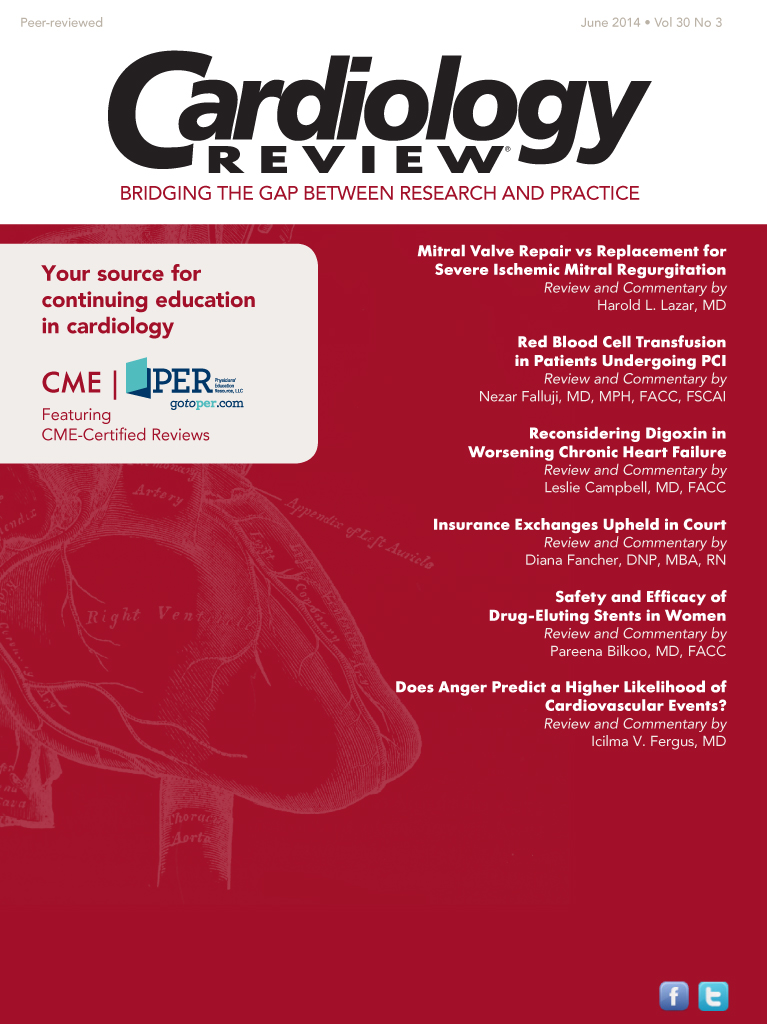Reconsidering Digoxin in Worsening Chronic Heart Failure
Should we give digoxin another look for chronic heart failure?

Leslie Campbell, MD, FACC
Review
J Am Coll Cardiol.
Ambrosy AP, Butler J, Ahmed A, et al. The use of digoxin in patients with worsening chronic heart failure: reconsidering an old drug to reduce hospital admissions.2014;63(18):1823-1832. doi:10.1016/j.jacc.2014.01.051.

T
he study by Ambrosy and colleagues provides a thorough review of the history, pharmacology, and research on digoxin. The objective is to consider whether there is evidence to support the use of digoxin in reducing hospital readmissions in patients with heart failure.
The authors first consider 2 prospective studies that focused on digoxin withdrawal (PROVED and RADIANCE),1,2 both of which concluded that digoxin lowered treatment failure. They also review the pivotal Digitalis Investigation Group (DIG) trial,3 a large (6800-patient) randomized, prospective study that compared digoxin with placebo in patients with ejection fraction (EF)
<
45% in normal sinus rhythm. In the main DIG trial, patients randomized to digoxin had no difference in all-cause mortality but did have a lower incidence of all-cause, cardiovascular, and heart failure—related hospitalizations. Those randomized to digoxin had a 2-fold increase in hospitalizations for suspected digoxin toxicity. The DIG ancillary trial included patients with higher EF (>45%) and found no effect on mortality or all-cause hospitalization.4
The authors also focus on studies that retrospectively analyzed digoxin—subgroup analyses of the data from the DIG, PROVED, and RADIANCE trials—to define that therapeutic serum digoxin concentrations both low (<1.0 mg/mL) and high had comparable effects, and make the argument that higher dose does not result in additional benefit.5-9
A post hoc analysis of the DIG trial found that survival was only improved in those patients with serum digoxin concentration <0.9 mg/mL, and that heart failure hospitalizations were reduced in the digoxin arm irrespective of digoxin levels.7
Gender differences are addressed through a retrospective analysis of the DIG trial, which found that women with serum digoxin concentrations >1.0 mg/mL were at higher risk of mortality.10 Men and women were equal compared with placebo with an inverse relationship between digoxin concentration and all-cause mortality.
High-risk groups identified in the DIG trial by retrospective analysis included: NYHA functional class III-IV, left ventricular ejection fraction (LVEF) <25%, and cardiothoracic ratio >55%. In these patients, digoxin reduced all-cause hospitalization and all-cause mortality.11
The authors then address the fact that retrospective analysis of DIG trial data demonstrated improved renal function (
>
20% increase in glomerular filtration rate) and note that improved renal function is associated with reduction in hospitalization.12,13
In contemporary databases, the AFFIRM trial, a non-randomized study about atrial fibrillation, found the use of digoxin was associated with increased mortality irrespective of heart failure.14 A post hoc analysis, however, found no evidence of increased mortality or hospitalization.15
The authors conclude that the evidence of reduced hospital admissions for both all-cause and heart failure-related admissions, in addition to the evidence of increased survival at lower serum concentrations (0.5 ng/mL to 0.9 ng/mL) and in certain high-risk groups (NYHA functional class III-IV, LVEF<25%, and cardiothoracic ratio >55%), supports the use of digoxin in patients experiencing worsening chronic heart failure despite standard therapy.
Ambrosy and colleagues cite the unique pharmacologic properties of digoxin, the only inotrope known to increase cardiac output and reduce pulmonary capillary wedge pressure (PCWP) without increasing heart rate or decreasing blood pressure. It does not have long-term deleterious effects, nor is its receptor upregulated. It may have synergistic effects with contemporary medications. It does not worsen renal function.
The authors suggest that outpatients enrolled in the DIG trial differed markedly from an unselected contemporary heart failure population in terms of demographics, and that an appropriately designed and powered randomized, double-blinded, placebo-controlled trial should be conducted in the setting of beta-blockers, angiotensin-converting enzyme inhibitors, or angiotensin receptor antagonists and mineralocorticoid receptor antagonists. They also suggest a separate trial with comorbid atrial fibrillation.
The authors further suggest that future digoxin trials have dosing focused on ranges between 0.0625 mg/d and 0.250 mg/d, and that clinicians be trained in efficacy versus toxicity. Finally, they suggest that with appropriate digoxin dosing, it may not be necessary to routinely measure serum digoxin concentration in most patients to achieve a safe and efficacious level.
CommentaryThe Last "Dig" Effort
T
he authors have done a superb job outlining the trials of digoxin that we have to draw from. They have also renewed thoughts about a medication that could still have a role in heart failure treatment. The interest is appropriately raised as a measure to reduce recurrent hospitalizations and their impact on the medical system. Health expenditures for 2013 consumed nearly 18% of the gross domestic product.16 Heart failure represents the most common cause of hospitalization in elderly patients, resulting in 6.5 million hospital days in the United States annually.17 Section 3025 of the Affordable Care Act added section 1886(q) to the Social Security Act establishing the Hospital Readmissions Reduction Program, which requires the Centers for Medicare & Medicaid Services (CMS) to reduce payments to Inpatient Prospective Payment System (IPPS) hospitals with excess readmissions, effective for discharges beginning on October 1, 2012.18
Unfortunately, the number of trials and analyses to draw from is limited and almost exclusive to the DIG trial, which was published in 1997.3 Much of the detail was from retrospective analysis from the DIG trial. PROVED and RADIANCE were withdrawal trials and did not demonstrate reduced readmissions or reduced mortality.2,3
In their conclusion, Ambrosy et al focus on one prospective trial to support their objective in reducing hospital readmissions. This trial predates beta-blockers and an improved understanding of the neurohormonal axis that supports spironolactone. It also predates device therapies and current computer technologies that are more likely to be able to reduce hospital readmissions.
The pharmacokinetics of digoxin as the only inotrope to increase cardiac output and reduce PCWP without decreasing blood pressure sounds attractive. But we work in a world of evidence-based medicine, and the evidence seems to rest with a single, now historical, trial. I agree with the authors that a contemporary trial would be of benefit if rekindling support for digoxin were to be sought.
Preventing readmissions will likely require a more comprehensive approach than simply adding digoxin. More effort is needed to identify high-risk patients.
I would suggest a heart failure—focused review of systems that surveys for fatigue, confusion, thirst, early satiety, and weight loss, and is not limited to orthopnea or edema. Encouraging identification of stages of heart failure rather than just NYHA functional class is needed. More comprehensive education is needed for patients about the need for sodium and fluid balance monitored by daily weight.
I would also suggest a more contemporary definition of high-risk patients that includes stage C and D heart failure, right ventricular systolic pressure (RVSP) >40, sodium (Na) <136, recurrent admissions (≥2 in 6 months), worsening kidney insufficiency, weight loss, and hypotension limiting medication titration.18
Recurrent admissions are a marker of advanced heart failure. We should be more forthcoming with our patients about heart failure as a terminal illness. Education, along with digoxin, is an integral part of the comprehensive treatment for any patient with stage C or D heart failure. Supported by the evidence about the patients most likely to benefit from digoxin, I recommend that when a prescription for digoxin is considered, the patient should also be referred for either palliative care or advanced heart failure therapies (ie, devices, mechanical circulatory support, or heart transplant).
Rather than focus on a somewhat archaic medication that has little prospective evidence to support its widespread use, I would favor exploring new sensor and computer technologies to monitor high-risk patients at home to prevent readmissions. For this reason, I thank the authors for renewed interest in digoxin, but I conclude that digoxin is a “last ‘dig’ effort” in heart failure treatment.
References
J Am Coll Cardiol
1. Uretsky BF, Young JB, Shahidi FE, Yellen LG, Harrison MC, Jolly MK. Randomized study assessing the effect of digoxin withdrawal in patients with mild to moderate chronic congestive heart failure: results of the PROVED trial. PROVED Investigative Group. . 1993;22:955-962.
. N Engl J Med
2. Packer M, Gheorghiade M, Young JB, et al. Withdrawal of digoxin from patients with chronic heart failure treated with angiotensin-converting-enzyme inhibitors. RADIANCE study. 1993; 329:1-7.
N Engl J Med.
3. The Digitalis Investigation Group. The effect of digoxin on mortality and morbidity in patients with heart failure. 1997;3336:525-533.
Circulation
4. Ahmed A, Rich MW, Fleg JL, et al. Effects of digoxin on morbidity and mortality in diastolic heart failure: the ancillary digitalis investigation group trial. . 2006;114:397-403.
J Am Coll Cardiol
5. Newton GE, Tong JH, Schofield AM, Baines AD, Floras JS, Parker JD. Digoxin reduces cardiac sympathetic activity in severe congestive heart failure. . 1996;28:155-161.
Circulation
6. Gheorghiade M, Hall VB, Jacobsen G, Alam M, Rosman H, Goldstein S. Effects of increasing maintenance dose of digoxin on left ventricular function and neurohormones in patients with chronic heart failure treated with diuretics and angiotensin-converting enzyme inhibitors. . 1995;92:1801-1807.
Eur Heart J
7. Ahmed A, Rich MW, Love TE, et al. Digoxin and reduction in mortality and hospitalization in heart failure: a comprehensive post hoc analysis of the DIG trial. . 2006;27:178-186.
J Am Coll Cardiol.
8. Slatton ML, Irani WN, Hall SA, et al. Does digoxin provide additional hemodynamic and autonomic benefit at higher doses in patients with mild to moderate heart failure and normal sinus rhythm?1997;29:1206-1213.
J Am Coll Cardiol.
9. Adams KF, Jr., Gheorghiade M, Uretsky BF, Patterson JH, Schwartz TA, Young JB. Clinical benefits of low serum digoxin concentrations in heart failure. 2002;39:946-953.
J Am Coll Cardiol
10. Adams KF, Jr., Patterson JH, Gattis WA, et al. Relationship of serum digoxin concentration to mortality and morbidity in women in the Digitalis Investigation Group trial: a retrospective analysis. . 2005;46:497-504.
Eur J Heart Fail
11. Gheorghiade M, Patel K, Filippatos G, et al. Effect of oral digoxin in high-risk heart failure patients: a pre-specified subgroup analysis of the DIG trial. . 2013;15:551-559.
J Cardiac Fail
12. Testani JM, Brisco MA, Tang WH, et al. Potential effects of digoxin on long-term renal and clinical outcomes in chronic heart failure. . 2013;295-302.
J Cardiac Fail
13. Vaduganathan M, Gheorghiade M. Return of digoxin and recovery of renal function. . 2013;19:303-305.
Eur Heart J.
14. Whitbeck MG, Charnigo RJ, Khair P, et al. Increased mortality among patients taking digoxin-analysis from the AFFIRM study. 2012;33:1787-1847.
Eur Heart J
15. Gheorghiade M, Fonarow GC, van Veldhuisen DF, et al. Lack of evidence of increased mortality among patients with atrial fibrillation taking digoxin: findings from post hoc propensity-matched analysis of the AFFIRM trial. . 2013;34:1489-1497.
Health Affairs
16. Keehan SP, Cuckler GA, Sisko AM, et al. National health expenditure projections: modest annual growth until coverage expands and economic growth accelerates. . 2012;31:1600-1612.
J Am Coll Cardiol.
17. Hunt SA, Abraham WT, Chin MH, et al. 2009 focused update incorporated into the ACC/AHA 2005 guidelines for the diagnosis and management of heart failure in adults: a report of the American College of Cardiology Foundation/American Heart Association Task Force on Practice Guidelines. 2009;53:e1-e90.
18. Centers for Medicare & Medicaid Services. Readmissions Reduction Program. http://www.cms.gov/Medicare/Medicare-Fee-for-Service-Payment/AcuteInpatientPPS/Readmissions-Reduction-Program.html.
Congest Heart Fail.
19. Russell SD. Advanced heart failure: a call to action. 2008;14:316-321.
About the Author
Leslie Campbell, MD,is medical director of advanced heart failure and transplant at the Barry S. Levin, MD Department of Transplantation at California Pacific Medical Center in San Francisco, CA.
